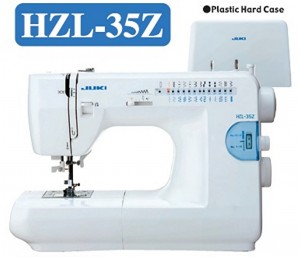 The Juki HZL-35Z sewing machine is a solid, smooth, precision machine with 27 built in stitches and a superior feed dog system. It’s a nice sized sewing machine with a blend of practical garment construction stitches, stretch stitches, and satin stitches.
The Juki HZL-35Z sewing machine is a solid, smooth, precision machine with 27 built in stitches and a superior feed dog system. It’s a nice sized sewing machine with a blend of practical garment construction stitches, stretch stitches, and satin stitches.
This machine is one of a handful that bring Juki’s strong reputation for industrial sewing machines to the home sewing machine market. It’s easy to use, reliable, and runs smoothly.
Table of Contents
(Click Ahead!)
Stitch Count / Presser Feet / Functionality / Accessories / Customer Reviews / Pros, Cons & Manual
REVIEW SUMMARY
MODEL: Juki HZL-35Z Sewing Machine
REVIEWED BY: Erin
RATING: 4.8 
LAST UPDATED: April 9, 2015
COMPARE PRICES
DISCONTINUED
Juki has been in the sewing machine business since the late 1930’s. Operating out of Japan and specializing in industrial sewing machines, they launched their home sewing machine models only a few years ago as a way of allowing those who loved their industrial quality to use the same technology at home at a much more affordable price. Their designs and technology have won a number of awards including the Deming Prize in 1981 for the quality control practices and improvements in their industrial sewing machine division.
Stitches Great for Home Decor and Clothing
(Back to Top)
There are a total of 27 stitch patterns on this model including a 1-step Bartack buttonhole. This particular combination of stitches is geared towards making clothes and home accessory projects. There are powerful overcasting stitches for heavy fabrics, some decorative satin stitches for additional detail, and all the popular utility stitches.
Stitch length is adjustable to 4mm and stitch width is adjustable to 6.5mm on the Zigzag stitch.
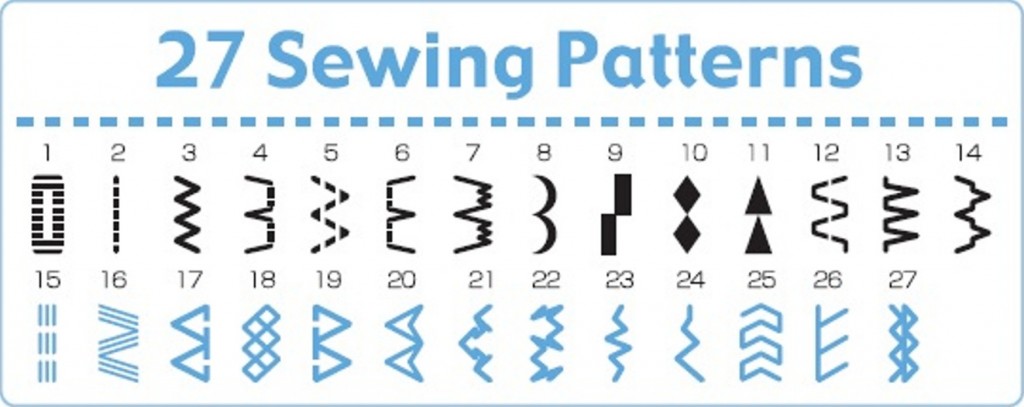
- Bartack Buttonhole
- Straight
- Zigzag
- Blind Hem
- Multi-stitch Zigzag (also known as Tricot)
- Shell Tuck
- Elastic Blind Hem
- Scallop
- Domino
- Diamond
- Arrowhead
- Rampart
- Overedge
- Faggoting
- Straight Stretch
- Ric Rac
- Overcast
- Honeycomb
- Overcast (reversed)
- Peak Point
- Crown
- Strong Stretch
- Pulse
- Chevron
- Knit Stitch
- Stacked Triangle
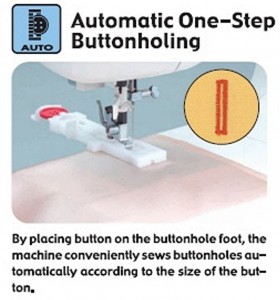
Four Standard Presser Feet
(Back to Top)
There are four snap-on presser feet. The General Purpose presser foot has a leveling button which can be used to navigate evenly over thick seams or to start the machine smoothly when working on thick layers of material.
- General Purpose with leveling button
- Zipper
- Blind Stitch
- Buttonhole Foot
Strong Feed Dogs and Helpful Features
(Back to Top)
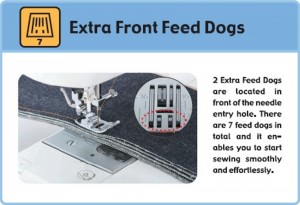 Because of Juki’s experience in the industrial and commercial use sewing machine market, even their home sewing machines utilize technology they know and rely on to guide fabric smoothly and evenly.
Because of Juki’s experience in the industrial and commercial use sewing machine market, even their home sewing machines utilize technology they know and rely on to guide fabric smoothly and evenly.
The feed dog s have 7 points of contact – the most superior feed dog system available on home sewing machines. Two leading points have been positioned just ahead of the needle in order to quickly and easily make contact with your fabric and pull it through under the needle without requiring any additional encouragement from the sewer. The feed dog system works well with all kinds of fabrics from sheers to really heavy denims, canvas and corduroy.
The machine comes with a number of other sewer friendly features, too:
- Automatic needle threader
- Top-loading, drop-in bobbin
- Automatic bobbin winder
- 2 Needle positions – left and center
- Pressure regulator so you can work with a variety of fabric types and see consistent fabric movement and stitches
- Adjustable top thread tension
- See-through bobbin cover
- Drop feed dog lever for free motion quilting, embroidery and darning
- Reverse button conveniently located above the needle arm
- Manual thread cutter on the extension arm
- Free-arm sewing with removal of extension arm
- Built in carry handle
- 6.6 inches of working space between the needle and the body of the machine
- Work light
- Maximum sewing speed of 700 stitches per minute
Dimensions: L 16.4” x H 11.8” x D 6.7”
Weight: 16 pounds
Accessories
(Back to Top)
Includes hard case, extension arm removes and has separated compartments for the included sewing accessories:
- Pack of needles
- 3 Bobbins
- 2 Spool caps (small and large)
- Combination seam ripper/brush
- 2 Screwdrivers (small and large)
- Oiler
You Might Not Know the Brand but they Earn Strong Ratings
(Back to Top)
Other buyers did a lot of homework before buying this machine because of the unfamiliarity with the brand in the home machine market. They’re certainly much more well known for their commercial machines. However, the majority were very pleased with the machine’s performance and thought it delivered very professional stitches.
It’s easy to use, doesn’t jam, and runs relatively quietly. Beginners found they didn’t need to keep referring back to the manual as the machine controls were self-explanatory after a little practice.
Average Rating: 4.8
Pros, Cons & Manual
(Back to Top)
![]() Pros: Smooth, even quality stitches. Reliable and sturdy – holds up well. Hard cover case included. Automatic needle threader. Nice assortment of utility, stretch and satin stitches. Superior feed dog system for fabric control. Easy, jam resistant bobbin system.
Pros: Smooth, even quality stitches. Reliable and sturdy – holds up well. Hard cover case included. Automatic needle threader. Nice assortment of utility, stretch and satin stitches. Superior feed dog system for fabric control. Easy, jam resistant bobbin system.
![]() Cons: Not the quietest of sewing machines. Hard cover does not lock onto the sewing machine for carrying but rests over it to protect from dust – still useful but not for carrying. Manual thread cutter is on the extension arm, not on the presser foot lever arm which is standard on many home sewing machines.
Cons: Not the quietest of sewing machines. Hard cover does not lock onto the sewing machine for carrying but rests over it to protect from dust – still useful but not for carrying. Manual thread cutter is on the extension arm, not on the presser foot lever arm which is standard on many home sewing machines.
Manual is not available online.
Manufacturer’s Warranty: As of this date, there is a limited warranty of two years on motors, light assembly, wiring, switches and speed control plus limited warranty of five years on all other parts excluding needles, loopers, feed dogs, knife blades, bulbs, lamps, and belts.
Features Summary Review:
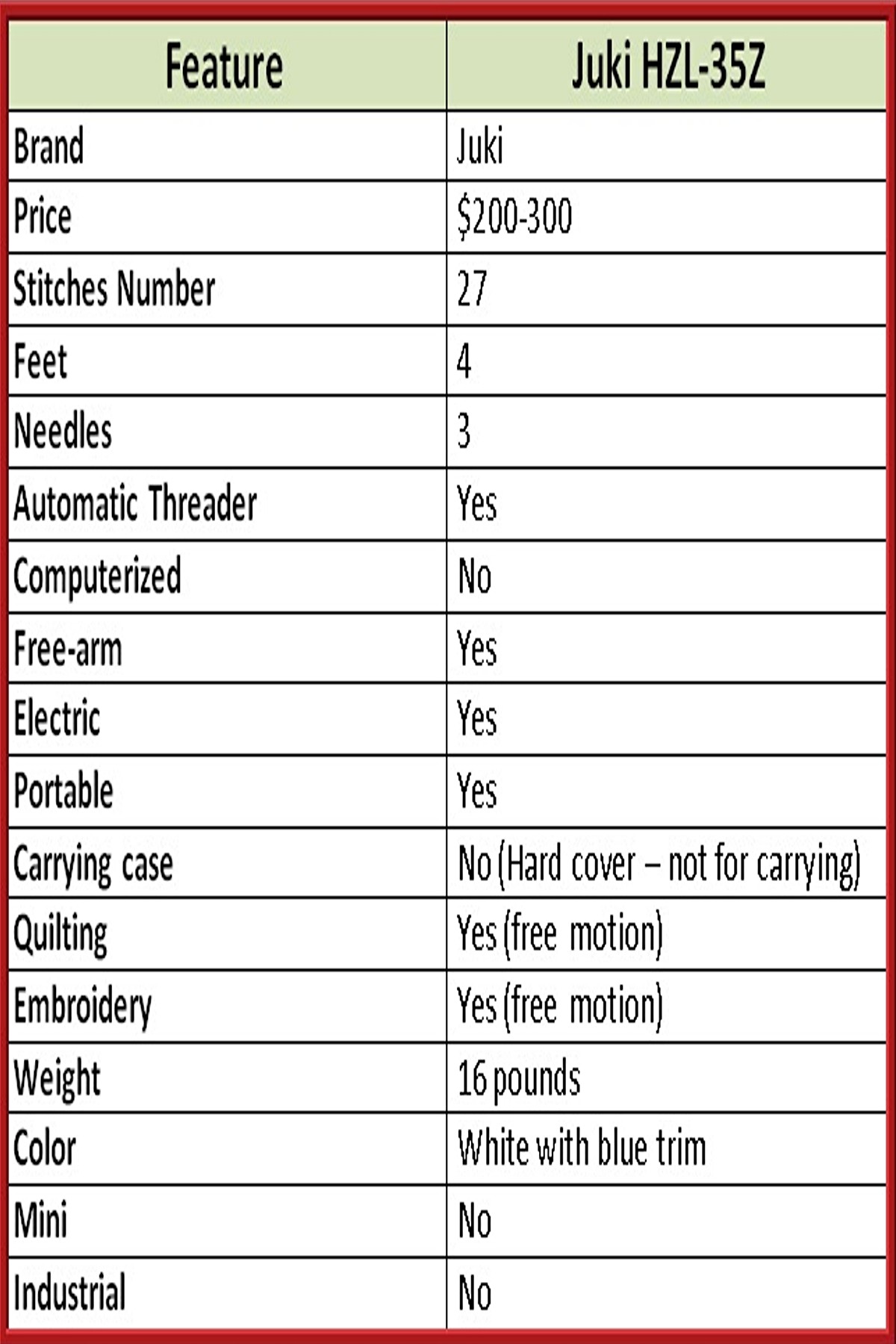
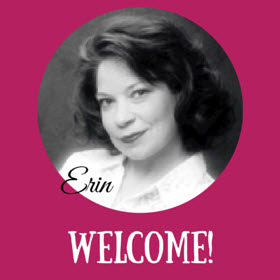
I am trying to decide between this machine and the Singer 7258. I know the Singer obviously has a ton more stitch options, and with the Juki I’d have a much more limited set of options. My sister has a higher end Juki that she uses for her sewing business, which got me interested in the brand. I want something reliable and a solid machine. Singer’s reputation makes me a little wary of purchasing one, but it seems like I can do more long term with the Singer 7258 than with the Juki HZL-35Z. I just wonder though how much I’ll need/want the decorative stitches if the machine is unreliable?? I use my current machine to sew quilt tops, some clothing, knitting project bags, and occasionally do some decorative stitch. Any advice would be very welcome!
Thank you
Emily – I can’t say that I have much experience with Juki so I don’t want to dissuade you from that model. However, I can say the reviews of the Singer 7258 have been consistently amazing. It hasn’t been out on the market as long but it has great features, lots of stitches, nice automation, is easy to use and people who have purchased that machine really seem to enjoy using it. There are other Singer models where you might be taking a risk investing in them, but I don’t think that’s the case with this one. It certainly would work for the projects you describe. The only regret I had after buying my last machine was that I didn’t hold out for more stitches. You never realize just how much you might use those extra stitches until you’ve run through all the ones you have and there’s no more to play with.
My two cents, anyway! Does that sort-of, kind-of help? 😉
Sincerely,
Erin
Is this machine able to use twin needles? If so, which ones would it need?
thanks
Manuel – Yes, the Juki HZL 35Z can use a twin needle. Most machines with a zigzag stitch can use a twin needle. However, I don’t know if there’s a spool pin hole for the second top thread. If not, then you’d need a thread stand to hold that thread. As for size, the maximum width of the zigzag stitch is 6.5mm. The first number on a twin needle size description is the mm of space between the two needles. You want to stay under the width of your zigzag stitch or the needles would be wider than the opening in the machine. The second number is the size of the needle itself and the size you’d need would depend on the kind of fabric you’re using.
Sincerely,
Erin
Thank you for the information. I was on the fence between this machine and the Janome 8077. I ended up choosing the Janome 8077 over this one because of the extra buttonhole stitches.
Manuel – I’m sure you’ll love the Janome 8077. I have the Magnolia 7330 which is a twin to the 8077 and it’s been a dream to use. Solid and reliable and excellent stitches.
Good luck!
Erin
Erin,
I just purchased the Juki Hzl 35z from Amazon today as a black Friday special as a Christmas present for my wife. This is meant to be an upgrade to her seven year old Singer Inspiration. Now I’m having second thoughts. Is this really an upgrade and if not -what would you recommend in the $200-$300 range. My wife mostly makes dresses for our daughter and herself. Thanks.
Erin,
I would like to thank you for this wonderful website. I was looking for my first sewing machine and trying to get information on all the available models was making my head spin. I did a Google search and fortunately came across your site and things were suddenly clear. Using the comparison chart I was able to easily compare price and features. I decided on the Juki and was able to get it for 179 instead of the 300 everyone else was asking. I also live near a Juki dealer so I have somewhere local to go when my machine needs maintenance. I haven’t received it yet but, I’m very excited and looking forward to learning to sew well. Thanks again!
Michael – I’m so happy you found the site and took the time to comment! Sounds like you made a great choice AND got a good deal. 😉
Enjoy your new machine and best wishes!
Sincerely,
Erin
Bad news. I received my Juki today and the presser foot level control was broken off. Now I’m scared because if it broke during shipping it must be very fragile so maybe instead of exchanging it for another, I should look for a machine that has metal parts instead of plastic. Would you happen to know of other makers that use metal instead of plastic parts?
Michael, that’s terrible! Of course, first contact the seller and see what they’ll do for you because it’s still a great machine and it’s very odd that one piece would be loose or break. As for machines that have all metal parts, I don’t have a list of them but if you’re talking interior and exterior pieces you’d be looking at lot more money – maybe something from the Bernina, Pfaff or Husqvarna lines. The higher end Janomes probably also have more metal pieces as do some of the Brother dealer-only models.
Good news! The seller exchanged the machine and now I have one that works. I had already downloaded the manual from the JUKI website so I could be ready when it arrived. So far things are going smoothly. I’m practicing with some cloth to get the feel of the machine and the foot pedal. I’m excited again!:) Thanks again Erin for this website. It really takes the frustration out of looking for a sewing machine, especially for first-time buyers like me.
Michael – I’m so glad to hear that! I’m sure you’ll have your fingers and foot flying along in no time. 😉 You’ll have to let us know when you finish your first project. Take care!
Hi Erin. Wow, I can’t believe it’s been almost a year since I purchased my JUKI. I’m really loving it! I’ve saved tons f money by hemming my own pants and altering my shirts. I even made my own pocket squares. My goal is to be able to make my own shirts, using a pattern. That will definitely be a big step! Have a great holiday!
Hi Erin,
I’m looking for a good beginner machine (for a friend) to teach a friend to sew. She needs a needle threader and electronics. What do you recommend? I want her to LOVE sewing (I do).
Thanks.